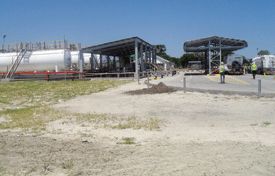Tourism boost as Puma unveils P30m aviation oil facility
Brian Benza
Staff Writer
| Saturday May 25, 2013 00:00


In a move that is expected to jack up the tourism sector, Puma Energy, already a dominant player in the aviation fuel industry in Botswana, last week unveiled a P30 million fuel storage and distribution facility that can simultaneously fuel up to seven aircraft. Speaking at the launch of the new facility, General Manager Mahube Mpugwa, said that because the entire tourism chain relies on the efficiency of the transportation system, they have enhanced the capacity of their aviation fuel infrastructure to 206 cubic metres for jet fuel or 21-day stock cover and 171 cubic metres for Avgas stock or 29-day cover.
' Maun as the fifth largest town is well known as the tourism capital of Botswana and it is the headquarters of many tourist outfits and air charter operations for easy transportation to the Okavango Delta and surrounding areas of interest. Against this backdrop we are providing state of the art fuel facilities, an investment that will directly benefit our tourism industry as we endeavour to provide reliable safe and efficient products and services,' he said.Jet fuel is used in turbine-engine jets while Avgas is the aviation fuel that powers the usually older and smaller piston-engine aircraft.
Over 70 small aircraft belonging to different airlines are stationed at the Maun Airport ferrying about 500 tourists a day in and out of the Okavango as well as between camps within the Delta. Puma also fuels chartered and international airliners apart from Air Botswana and Botswana Defence Forces (BDF) planes.The doubling of the Puma infrastructure capacity comes at a time when the airport, believed to be the busiest in Southern Africa in terms of frequency of passenger aircraft landings, is undergoing expansion and facelift meant to accommodate more and larger aircraft as well as increased passengers.In an interview with Monitor Business, Airport Manager Larona Mokete said that the first phase of the airport expansion, which included extending the runway and taxiway, was completed last year at a cost of about P500 million.
'The runway was extended from 2.5km to 3.7km, allowing bigger aircraft such as Boeing 737 to land here. We are now currently working on expanding the airport services area and after that we will move on to the construction of a new terminal building,' he said. Between 200 and 250 passenger aircraft land at Maun airport a day, most of them smaller planes, with between 4-14 passenger seats. Civil Aviation Authority of Botswana (CAAB) figures recently published by Statistics Botswana indicate that between January and September last year, Maun Airport was the country's busiest in terms of aircraft movements, with 36,084 local and international aircraft movements or nearly 60 percent of all landings and take-offs in and from the country.
On average 600 passengers pass through the airport everyday, second only to Sir Seretse Khama International Airport (SSKIA) in Gaborone.Meanwhile, Puma says plans are underway to also expand aviation fuel storage and distribution infrastructure at the Gaborone airport by building a 600 cubic metres jet A-2 storage tank this year, a development that will be expected to increase the country's ability to sustain its aviation fuel supply during times of shortages. Puma, which started operating in Botswana in January 2011 after taking over the operations of BP, is the leader in fuelling the aviation and mining industries in Botswana with supply contracts with companies like Debswana, BCL, BDF, BPC - power peaking plants in Orapa and Matshelagabedi, and the other small mines in the country.
